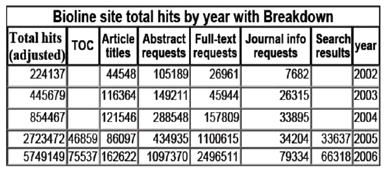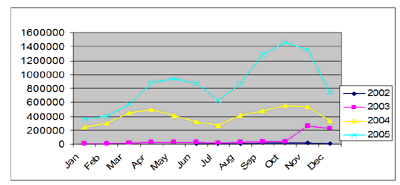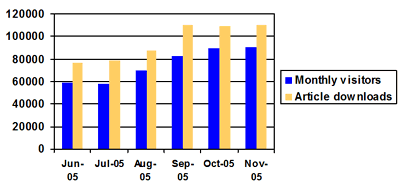In the latest of BioMed Central’s occasional series of guest blog items, Barbara
Kirsop of the Electronic
Publishing Trust for Development reports from the 5th Berlin open access conference:
The Berlin 5 conference was the 5th
follow-up meeting since the launch of the Berlin Declaration, and a special
session on the impact of Open Access (OA) on developing country science was
organised by EPT Trustee Subbiah Arunachalam. I attended as a speaker, together
with Dr D K Sahu from MedKnow Publications, India, and Stefka Kalayonova from
FAO. The programme is available from https://www.aepic.it/conf/papers.php?cf=10
and abstracts can be found by selecting ‘papers’. Powerpoint presentations and a video webcast are to be made available later.
It
should first be reported that there were excellent presentations from the EU
Commission, the European Science Foundation, universities, institutes and OA
organisations – all describing their activities in further promoting OA developments,
both technical and policy related. It is now clear that OA is here to stay and
will form, together with associated OA data, the bedrock of scholarly research
information exchange in the future. Although
some of the old issues continue to be raised by newcomers to OA (and by a
diminishing band of OA-deniers), the debate seems to be moving on from
establishing institutional repositories and OA journals to infrastructure
support for repositories, usage statistics of OA journals, research into improved
search and analysis tools and the importance of OA data to aid the discovery of
new scientific information This is excellent news for developing countries who
at last see a light at the end of the tunnel for levelling the playing field.
Turning
to the developing country (DC) session, it is very disappointing to report that
this attracted an audience of little over 20! This may have been because of a
parallel session on ‘Open Issues in Open Access’, which attracted nearly all the
~300 participants (standing room only), or it may be that the richer countries
feel they ‘know it all’ and have little need to heed DC research. But the panel
had important facts to report on the impact of OA on DC science, and academics
in the developed regions should recognise the need for DC research in solving
such global problems as infectious diseases, environmental disasters, HIV/AIDS
etc.
Before
OA: I had
been asked to present an overview of OA developments in the developing
countries. I used the results of a 2003 WHO survey of medical institutes to
show the dire pre-OA position of access to essential literature in the poorest
countries. In countries with a GDP/capita/year< $1000, 56%
of medical institutes surveyed had been unable to purchase any subscriptions to
journals over the previous 5 years, and the situation was little better in the
next economic band of countries. I went on to show what improvements have taken
place since the advent of OA.
OA
Journals and Institutional Repositories: I showed that the initiatives of Bioline
International (https://www.bioline.org.br,
Brazil/Canada), SciELO (https://www.scielo.br
Brazil and other Latin American countries), MedKnow (https://www.medknow.com, India) and other
non-profit services had resulted in the establishment (or conversion to OA) of
537 journals out of a total of 2802 recorded in the Directory of open Access
Journals (https://www.doaj.org). This shows
that ~20% of all O A journals are published in DCs. None of these journals make
author charges, all provide full text access. It is clear from these figures
that the research community in low-economy countries values incorporation into
the international knowledge pool above the income that could be gained from
closed access. A similar situation can be shown with OA institutional
repositories. Of the ~915 IRs listed in the Registry of OA Repositories (https://roar.eprints.org), 143 (~16%) are in
DCs. The low cost of establishing IRs means that this route to OA is affordable
and manageable by DCs.
But
are these resources being used by the research community in the DCs? Are they
making a difference? I reported on figures for OA journal usage from Bioline
International and SciELO, leaving Dr D K Sahu to report on usage of journals
published by MedKnow in India.
Some
statistics: The
usage of journals from 17 different DC countries using the Bioline distribution
system is impressive. The following table shows that in 2006, 2.5 million
requests for full text articles were received, and 2007 figures show a
continuing upward trend.

Similar
usage figures are obtained for Latin American ScIELO journals, as the article
downoload chart from Chile shows, below.

Statistics
from the OA Indian biomedical journal service, MedKnow, Mumbai, show similarly impressive
figures for usage of articles, for increased impact factors, for submissions (both
Indian and international), and even for increased subscriptions since
conversion to OA. Income is derived from sales of printed copies, services to
publishers, advertisements – and it is notable that author charges are not made
and do not contribute to financial viability of the journals, since this would
clearly be a burden to authors from the developing world.
MedKnow
statistics:
Article
submissions

Downloads
and visitors

Effect
of OA (begun in 2002) on subscriptions

The
upward trend of all these parameters continue through to 2007 and can be
requested from the service providers.
The
GeoMaps show that usage comes both from the developing and developed world,
indicating a powerful usage of free research findings by scientific communities
in the otherwise information-deprived countries, and a parallel interest from
international research communities for information generated in the developing
regions. This is a very healthy trend, since the resolution of climate change
problems and the containment and treatment of infectious pandemics requires
access to local knowledge if appropriate programmes are to be devised.
I
heard recently a comment from an EU university business department who thought
that OA in DCs had ‘fizzled out’. If this is the fizzling out of a damp squib,
I cannot imagine what a skyward rocket would reveal. DCs are lapping up OA
resources, but there is clearly more awareness raising and advocacy to be done.
Developments
in Africa, as provided by Eve Gray, OSI and University of Cape Town, show a number of
initiatives now underway in the continent that can be expected to begin to
impact in 2008. In addition we heard from FAO of the new initiatives to set up
IRs and encourage the provision of access to FAO information on an OA basis. It
will be very encouraging if the UN agencies accelerate the use of OA resources
in this way. However, one of the 20 in our audience felt that the UN donor
programmes (AGORA, HINARI, OARE) were merely tools for partner publishers and
that usage of their programmes was low.
Of
concern, and focussing still on UN attitudes to sharing research data and
publications, a paper by Illaria Capua, Italy, described the terrible effects
of avian influenza on communities in the developing nations where the poultry
industry and rural farming have been devastated. Her laboratory successfully
isolated the H5N1 virus from Africa and wanted to deposit the sequence data in
Genbank, but was asked to deposit it in a controlled access WHO database. She
was applauded when she described her insistence on depositing the data in
Genbank.
In
the corridors: Another issue of concern to developing country publishers was gleaned
‘in the corridors’, where I learned that large western for-profit publishers
have begun to contact the increasingly successful DC journals with a view to
taking them over. This commercial activity is worrying since it is the DC
scientists and publishers themselves that have raised the standard of the
journals and made them attractive for take-over. It may be very difficult for
hard-pressed DC organisations to resist tempting offers from large publishers,
but we must hope they do not bow to these approaches, since the existence of a
flourishing scientific publishing environment strengthens the science base of
countries which, in turn, is recognised as being essential for the development
of strong economies.
I
hope this report will be of interest to BMC readers and that it shows the
very positive impact that OA is having on DC science and, in this
interconnected world, on us all. It is difficult to see how many of the
Millennium Development Goals can be reached without free access to the world’s
research findings and it seems to be widely accepted now that OA alone can significantly accelerate scientific
progress and benefit the poorer 80% of the world. But there remains much to be
done and the new BMC portal is a welcome and positive step forward.
Barbara Kirsop, Electronic
Publishing Trust for Development
Statistics
provided by Bioline International, https://www.bioline.org.br,
MedKnow
Publications, https://www.medknow.com and
SciELO https://www.scielo.org
Comments